Philipp Schoenegger
Outcome-based Reinforcement Learning to Predict the Future
May 26, 2025
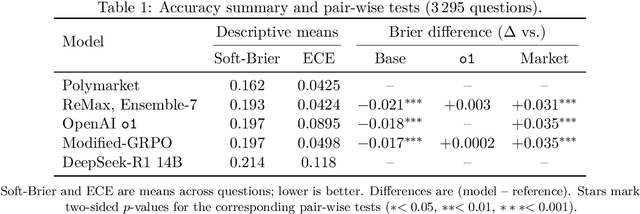
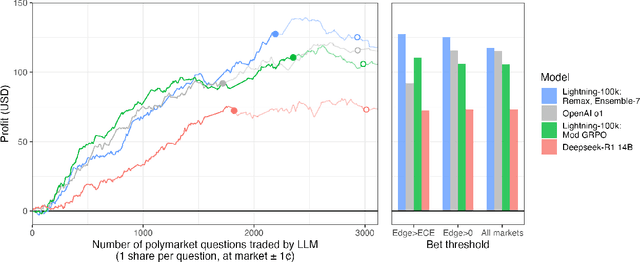

Abstract:Reinforcement learning with verifiable rewards (RLVR) has boosted math and coding in large language models, yet there has been little effort to extend RLVR into messier, real-world domains like forecasting. One sticking point is that outcome-based reinforcement learning for forecasting must learn from binary, delayed, and noisy rewards, a regime where standard fine-tuning is brittle. We show that outcome-only online RL on a 14B model can match frontier-scale accuracy and surpass it in calibration and hypothetical prediction market betting by adapting two leading algorithms, Group-Relative Policy Optimisation (GRPO) and ReMax, to the forecasting setting. Our adaptations remove per-question variance scaling in GRPO, apply baseline-subtracted advantages in ReMax, hydrate training with 100k temporally consistent synthetic questions, and introduce lightweight guard-rails that penalise gibberish, non-English responses and missing rationales, enabling a single stable pass over 110k events. Scaling ReMax to 110k questions and ensembling seven predictions yields a 14B model that matches frontier baseline o1 on accuracy on our holdout set (Brier = 0.193, p = 0.23) while beating it in calibration (ECE = 0.042, p < 0.001). A simple trading rule turns this calibration edge into \$127 of hypothetical profit versus \$92 for o1 (p = 0.037). This demonstrates that refined RLVR methods can convert small-scale LLMs into potentially economically valuable forecasting tools, with implications for scaling this to larger models.
Large Language Models Are More Persuasive Than Incentivized Human Persuaders
May 14, 2025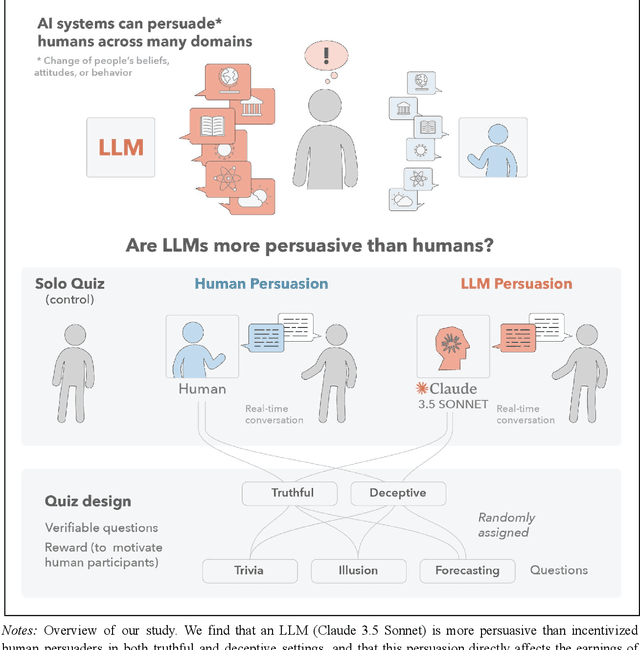
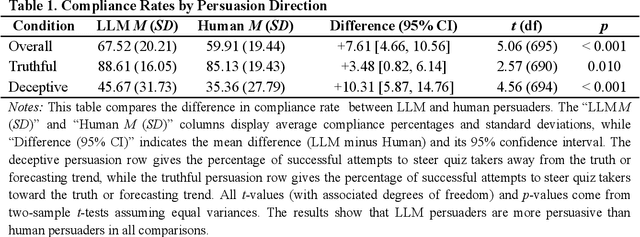
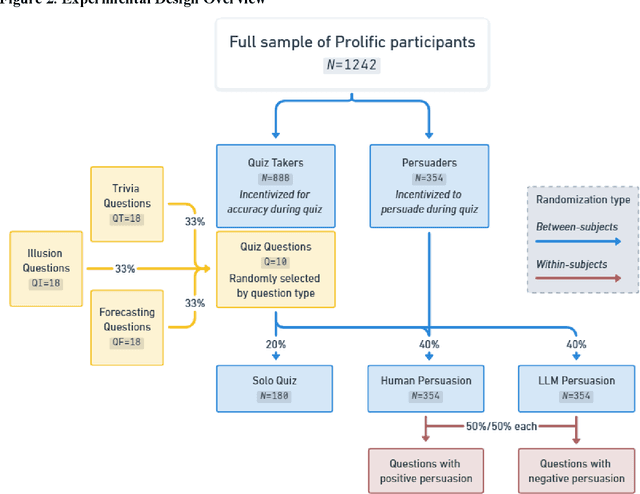
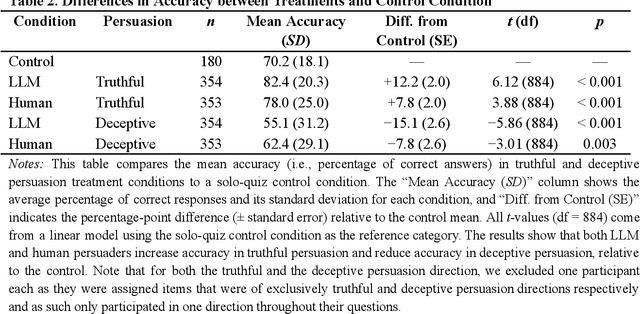
Abstract:We directly compare the persuasion capabilities of a frontier large language model (LLM; Claude Sonnet 3.5) against incentivized human persuaders in an interactive, real-time conversational quiz setting. In this preregistered, large-scale incentivized experiment, participants (quiz takers) completed an online quiz where persuaders (either humans or LLMs) attempted to persuade quiz takers toward correct or incorrect answers. We find that LLM persuaders achieved significantly higher compliance with their directional persuasion attempts than incentivized human persuaders, demonstrating superior persuasive capabilities in both truthful (toward correct answers) and deceptive (toward incorrect answers) contexts. We also find that LLM persuaders significantly increased quiz takers' accuracy, leading to higher earnings, when steering quiz takers toward correct answers, and significantly decreased their accuracy, leading to lower earnings, when steering them toward incorrect answers. Overall, our findings suggest that AI's persuasion capabilities already exceed those of humans that have real-money bonuses tied to performance. Our findings of increasingly capable AI persuaders thus underscore the urgency of emerging alignment and governance frameworks.
LLMs Can Teach Themselves to Better Predict the Future
Feb 07, 2025Abstract:We present an outcome-driven fine-tuning framework that enhances the forecasting capabilities of large language models (LLMs) without relying on human-curated reasoning samples. Our method leverages model self-play to generate pairs of diverse reasoning trajectories and probabilistic forecasts for a set of diverse questions that resolve after the models' knowledge cutoff date. We then rank pairs of these reasoning traces by their distance to the actual outcomes before fine-tuning the model via Direct Preference Optimization (DPO). On a separate test set, our approach increases prediction accuracy of Phi-4 14B and DeepSeek-R1 14B by between 7--10\% over a base model and a DPO fine-tuned control model with randomized labels, bringing them on par with forecasting capabilities of much larger frontier models like GPT-4o.
Wisdom of the Silicon Crowd: LLM Ensemble Prediction Capabilities Rival Human Crowd Accuracy
Mar 06, 2024



Abstract:Human forecasting accuracy in practice relies on the 'wisdom of the crowd' effect, in which predictions about future events are significantly improved by aggregating across a crowd of individual forecasters. Past work on the forecasting ability of large language models (LLMs) suggests that frontier LLMs, as individual forecasters, underperform compared to the gold standard of a human crowd forecasting tournament aggregate. In Study 1, we expand this research by using an LLM ensemble approach consisting of a crowd of twelve LLMs. We compare the aggregated LLM predictions on 31 binary questions to that of a crowd of 925 human forecasters from a three-month forecasting tournament. Our preregistered main analysis shows that the LLM crowd outperforms a simple no-information benchmark and is not statistically different from the human crowd. In exploratory analyses, we find that these two approaches are equivalent with respect to medium-effect-size equivalence bounds. We also observe an acquiescence effect, with mean model predictions being significantly above 50%, despite an almost even split of positive and negative resolutions. Moreover, in Study 2, we test whether LLM predictions (of GPT-4 and Claude 2) can be improved by drawing on human cognitive output. We find that both models' forecasting accuracy benefits from exposure to the median human prediction as information, improving accuracy by between 17% and 28%: though this leads to less accurate predictions than simply averaging human and machine forecasts. Our results suggest that LLMs can achieve forecasting accuracy rivaling that of human crowd forecasting tournaments: via the simple, practically applicable method of forecast aggregation. This replicates the 'wisdom of the crowd' effect for LLMs, and opens up their use for a variety of applications throughout society.
AI-Augmented Predictions: LLM Assistants Improve Human Forecasting Accuracy
Feb 12, 2024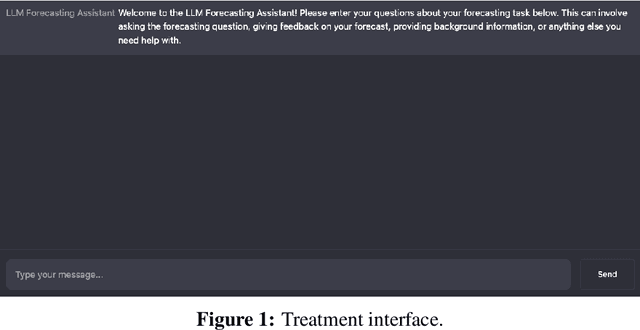

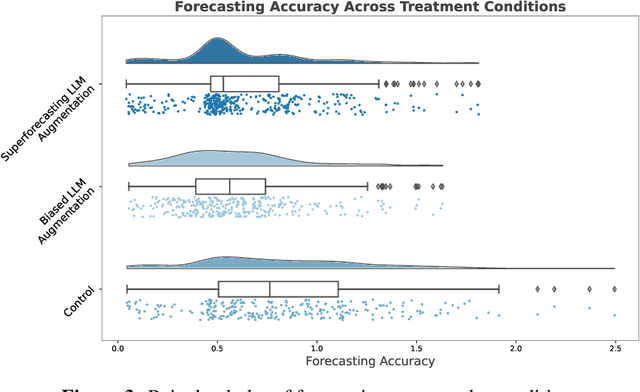
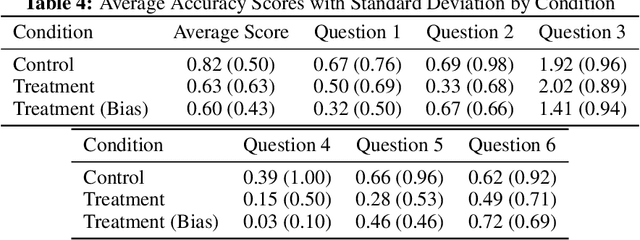
Abstract:Large language models (LLMs) show impressive capabilities, matching and sometimes exceeding human performance in many domains. This study explores the potential of LLMs to augment judgement in forecasting tasks. We evaluated the impact on forecasting accuracy of two GPT-4-Turbo assistants: one designed to provide high-quality advice ('superforecasting'), and the other designed to be overconfident and base-rate-neglecting. Participants (N = 991) had the option to consult their assigned LLM assistant throughout the study, in contrast to a control group that used a less advanced model (DaVinci-003) without direct forecasting support. Our preregistered analyses reveal that LLM augmentation significantly enhances forecasting accuracy by 23% across both types of assistants, compared to the control group. This improvement occurs despite the superforecasting assistant's higher accuracy in predictions, indicating the augmentation's benefit is not solely due to model prediction accuracy. Exploratory analyses showed a pronounced effect in one forecasting item, without which we find that the superforecasting assistant increased accuracy by 43%, compared with 28% for the biased assistant. We further examine whether LLM augmentation disproportionately benefits less skilled forecasters, degrades the wisdom-of-the-crowd by reducing prediction diversity, or varies in effectiveness with question difficulty. Our findings do not consistently support these hypotheses. Our results suggest that access to an LLM assistant, even a biased one, can be a helpful decision aid in cognitively demanding tasks where the answer is not known at the time of interaction.
Large Language Model Prediction Capabilities: Evidence from a Real-World Forecasting Tournament
Oct 17, 2023Abstract:Accurately predicting the future would be an important milestone in the capabilities of artificial intelligence. However, research on the ability of large language models to provide probabilistic predictions about future events remains nascent. To empirically test this ability, we enrolled OpenAI's state-of-the-art large language model, GPT-4, in a three-month forecasting tournament hosted on the Metaculus platform. The tournament, running from July to October 2023, attracted 843 participants and covered diverse topics including Big Tech, U.S. politics, viral outbreaks, and the Ukraine conflict. Focusing on binary forecasts, we show that GPT-4's probabilistic forecasts are significantly less accurate than the median human-crowd forecasts. We find that GPT-4's forecasts did not significantly differ from the no-information forecasting strategy of assigning a 50% probability to every question. We explore a potential explanation, that GPT-4 might be predisposed to predict probabilities close to the midpoint of the scale, but our data do not support this hypothesis. Overall, we find that GPT-4 significantly underperforms in real-world predictive tasks compared to median human-crowd forecasts. A potential explanation for this underperformance is that in real-world forecasting tournaments, the true answers are genuinely unknown at the time of prediction; unlike in other benchmark tasks like professional exams or time series forecasting, where strong performance may at least partly be due to the answers being memorized from the training data. This makes real-world forecasting tournaments an ideal environment for testing the generalized reasoning and prediction capabilities of artificial intelligence going forward.
Artificial intelligence in psychology research
Feb 16, 2023Abstract:Large Language Models have vastly grown in capabilities. One potential application of such AI systems is to support data collection in the social sciences, where perfect experimental control is currently unfeasible and the collection of large, representative datasets is generally expensive. In this paper, we re-replicate 14 studies from the Many Labs 2 replication project (Klein et al., 2018) with OpenAI's text-davinci-003 model, colloquially known as GPT3.5. For the 10 studies that we could analyse, we collected a total of 10,136 responses, each of which was obtained by running GPT3.5 with the corresponding study's survey inputted as text. We find that our GPT3.5-based sample replicates 30% of the original results as well as 30% of the Many Labs 2 results, although there is heterogeneity in both these numbers (as we replicate some original findings that Many Labs 2 did not and vice versa). We also find that unlike the corresponding human subjects, GPT3.5 answered some survey questions with extreme homogeneity$\unicode{x2013}$with zero variation in different runs' responses$\unicode{x2013}$raising concerns that a hypothetical AI-led future may in certain ways be subject to a diminished diversity of thought. Overall, while our results suggest that Large Language Model psychology studies are feasible, their findings should not be assumed to straightforwardly generalise to the human case. Nevertheless, AI-based data collection may eventually become a viable and economically relevant method in the empirical social sciences, making the understanding of its capabilities and applications central.
 Add to Chrome
Add to Chrome Add to Firefox
Add to Firefox Add to Edge
Add to Edge